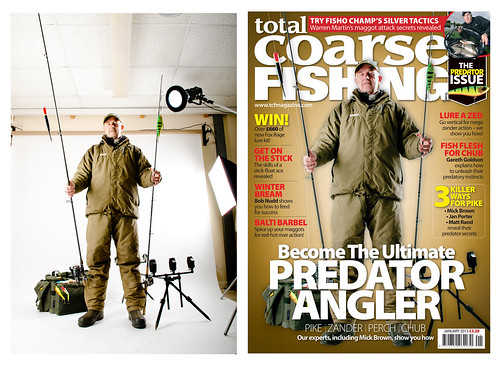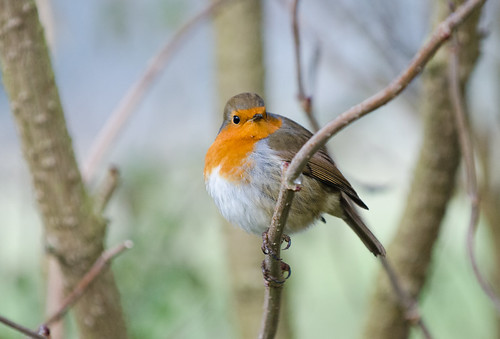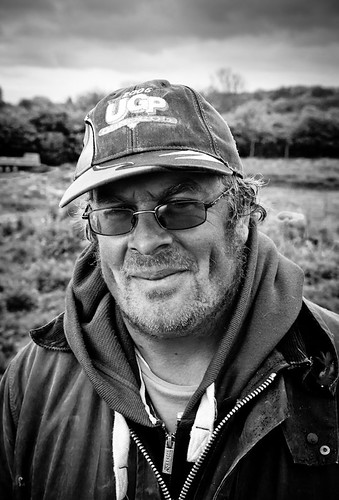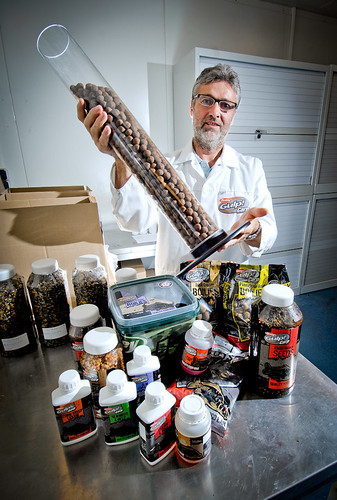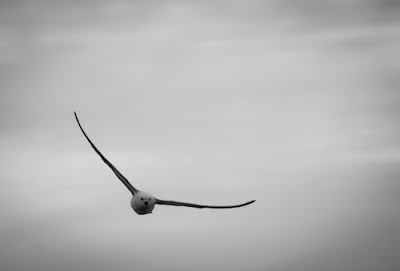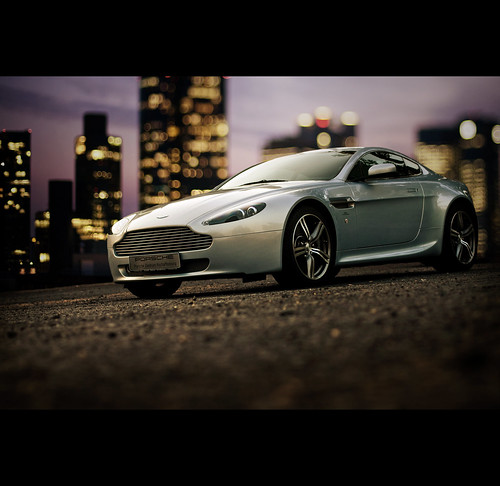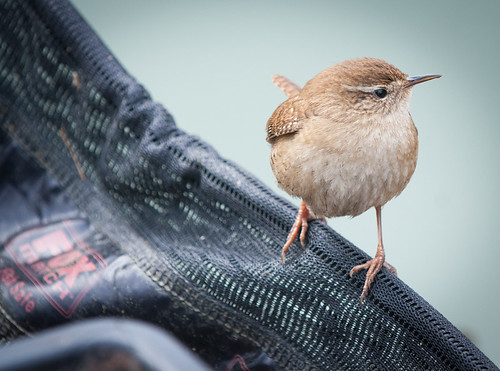It's always exciting when editors work with you on a concept, especially when it comes to covers that push the envelope.
Traditionally, our fishing mag covers have always featured a man with fish, a man with a net of fish, or on odd occasions, a man playing a fish. However, the new editor of TCF really wanted to create a 'hero' shot that would stand out on the crowded newsstand so we took our lead from an issue of Field & Stream where a hunter was nicely lit holding his hunting equipment. We decided to use a different kind of 'hunter', well-known predator angler Mick Brown.
The studio space at work is 'bijou' to say the least so we had to work around the amount of working area; to camera left are two 24" soft boxes stacked on top of each other to replicate a strip box for soft fill, and you can see the other two lights and what they're achieving.
There's obviously a considerable crop taken place to fit the image on the cover, plus some heavy Photoshopping. However, as a cover that stands out from the crowd I'm really pleased with what we achieved.... sales will tell if we made the right decision, but nonetheless we've produced something we can be proud of.
*Nikon D7000
*Nikon 17-55mm f/2.8
*ISO 100
*1/250th @ f/7.1
Tuesday, 18 December 2012
Magazine cover concept
Wednesday, 12 December 2012
Robin
Just a quick snap from today's feature with Bob Nudd for UK fishing magazine, Total Coarse Fishing.
This cheeky little robin was doing the usual winter trick - look cute and then steal maggots form your bait tray. I couldn't begrudge him that when he was so willing to model for the camera!
*Nikon D7000
*Nikon 70-200mm VR
*ISO 1600
*1/320th @ f/4
Wednesday, 21 November 2012
New Toy...
Tuesday, 28 August 2012
REVIEW: Nikon 300mm f/4 AF-S
Wednesday, 1 August 2012
More work! Yes please....
Tuesday, 15 May 2012
It's good to cheat....
Today I was out for a carp fishing magazine and with the weather being crap, we had tiny windows in-between the rain to get shots done. One shot on the list was feeding bait into the margins. I knew the focus was on the splash of the bait so threw the angler out of focus in the background using f/2.5. Unfortunately, when you're working quick like this you do hit upon mistakes that you don't realise until you get back to base.
In this case the best splash had the angler, Rik, with his throwing arm by his side so it just looked like some random stuff hitting the water. I knew I had another shot with his arm outstretched so that was a good starting point to do a merge.
I rarely use a tripod because I work quickly so there was obvious discrepancy in the angle of the horizon between shots. Thankfully, I'd shot wide to give some room for cropping. However, with the wind howling, the reeds where the bait was hitting was blowing all over the place and didn't stay still between shots.
In Photoshop I overlaid the shots then applied a layer mask so I could uncover parts of one shot yet leave in bits of another. This merge is relatively straight forward; a gradient mask and then a bit of brushwork to tidy things up. The result is acceptable and although it's been Photoshopped, I don't class it as a fake - it's just a shot that I improved from circumstances that were hard to shoot in.
Sunday, 13 May 2012
Making A Magazine Feature
I'm quite trigger-happy while I'm out on shoots, working on that little-known adage of 'more is more'. I ALWAYS make sure that I have more images than I need, whether that's the same shot from a variety of angles, or just different exposures of the same shot, with differing light, aperture values and ISOs thrown into the mix. It's all about covering your arse as much as possible and making sure that you give the editorial staff and design team enough material to work with. Keep them sweet and things are good!
To explain, I've revisited a shoot I did at the start of the year;
The angler, Ade Kiddell, is experienced and very willing to do whatever I tell him to do, whether that's re-casting several times or just holding a fish as I want. Anglers like this are a joy to work with. A journalist was in attendance - I rarely do any editorial writing these days - so that also made my life a bit easier because we could talk about the brief on the way there and adapt it as we saw fit through the day.
Anyway, we'd come to the River Wensum to shoot a piece on bread fishing. The fishing wasn't going to be easy but we had a chance of chub - in fact, Ade had one pretty much straight away so that was the important part done. Thankfully, chub deal with being keep netted quite well so he was retained for more shots later. It's always nice to get at least one fish in the bag when you're doing features about bigger fish, because it puts me at ease and allows me to focus on the incidentals and sequence shots.
So, the feature gets wrapped up after having a few fish and doing all the shots we'd talked about. Job done so far but then it's a case of working out what images work best. My instructions for the the types of shots depend on the magazine; some editors want things shot in a specific manner, but most just let me take creative control. We knew a pic of a big chub would work well, especially at a time of year (March issue) when big fish weren't exactly throwing themselves on the bank to be photographed. I also had to make sure sequences were submitted, plus some incidentals of Ade fishing, casting, netting, holding up tackle etc...
The images are loaded into Lightroom 3 and then the key wording and metadata is synced, then it's a case of selection. As you can see from the screen shot, there are 139 images in this specific folder; not a massive shoot by any stretch, but enough to gee me plenty of options. The ones of out-of-focus grass and the backs of people's heads while setting up flashes are rejected and then I go through and from each set of shots, I pick the best one, giving it a five-star rating. These 'keepers' are selected by how they'll process, how the focus and depth-of-field look and whether facial expressions and such-like are acceptable.
Once I have my five-star images I then get to work doing adjustments; sharpening, fill adjustment with black point and contrast are typical ones, as is noise reduction. I rarely crop or straighten, because the designer is going to be placing the images so they may end up as cut-outs and the horizon won't appear anyway.
Then it's a case of the editor teaming the images up to the copy (the text) and submitting his final choice in a job bag to the designer with any instructions about image placement, sequences and which images are available as main (opening) images.
As you can see by the final feature, the 'grip-and-grin' of the angler with a fish made the opening spread, with sequences and incidentals over the remaining spread. Am I happy? Yes, and I know that my editing procedure ultimately influenced the images that made it into the feature. Job done :)
Wednesday, 9 May 2012
Peter
Took this today while out on a shoot in Essex at a trout fishery.
This is Peter, he's the fishery manager and a thoroughly nice bloke. Looks-wise he's a tad rough around the edges but as far as fishery staff go, he's one of the most welcoming I've met. Oh, and he also sound like Harry Hill.
EXACTLY like Harry Hill.
All I could think about was the knitted toy and people in crazy suits having fights on stage!!
*Nikon D2x
*Nikon 17-55mm f/2.8 AF-S
*ISO 100
*1/250th @ f/6.3
*SB-700 through softbox from camera left (power set to 1/8th)
*Processed in LR3
Monday, 16 April 2012
The Fishing Scientist
An old shot I unearthed while browsing my archive.
I took this during a trip to Berkley's Gulp bait factory in southern Holland. This was a press trip so there were all sorts of people who were trying to get shots of the chief scientist called Franz (or it could have been Frank - he dazzled me with science!).
Because of the melee of journos all wanting to get something for their mags, I had to work quickly so just set up an SB-800 in SU-4 mode behind him, with an SB-800 from camera right trigered by an Elinchrom Skyport. The shoot took about three minutes from start to finish before we headed out to the coach back to the airport.
Can't rememebr the settings but it was all manual obviously.
*Nikon D2x
*Nikon 12-24mm f/4
*ISO 200
*1/100th @ f/8
Although it did the job, this is the kind of shot I look back on and think "I wish I'd done it differently". The shot is fine in general and fitted what the mag wanted, but I know now that there needed to be more fill on the labels, the ambient needed to be dialled down in the background, and a gel on the rear flash could have given it more impact.
Still, it was true 'on-the-fly' indoor shooting, something I don't get a chance to do very often....
Sunday, 15 April 2012
Flatholm Island
Between massive thunderstorms and epic hail (and waiting for fish to bite) I thought I'd grab a shot of Flatholm, one of the islands that lie in the Bristol Channel.
*Nikon D2x
*Nikon 70-200mm f/2.8
*ISO 400
*1/4000th @ f/5.6
Friday, 30 March 2012
Nab Tower
Via Flickr:
I was out on a very long (18-hour) shoot today in the Solent, off the isle of Wight. The feature was to get stock images for Total Sea Fishing magazine aboard 'Wight Huntress'.
While steaming around we motored very close to the impressive Nab Tower, an anti-submarine instalment from WW1. It's a well-known point for sailors, denoting the deep water entrance to the Solent.
It's an impressive structure even if it does have a bit of a lean - covered in rust and against an azure blue sky it looked great, and although I originally envisioned a mono conversion would suit the detail in the iron work better, in colour it does have a certain impact.
More details about the tower - en.wikipedia.org/wiki/Nab_Tower
*Nikon D2x
*Nikon 17-55mm f/2.8
*ISO 100
*1/100th @ f/9
*Processed in Lightroom 3
Tuesday, 27 March 2012
Hustle & Bustle
Via Flickr:
This was taken at the NEC (national Exhibition Centre) during the recent FocusOnImaging2012 show, one of major photographic expos.
I go every year to have a play with new kit, buy some essentials and watch some great seminars from the major players.
This was taken in the main atrium outside the show at the end of the penultimate day. The NEC is totally a 1980s site and the design, although not something you'd say was classic, does have its interesting elements such as these brilliant ceiling windows.
Shot on my trusty HTC Desire HD, I just set it to a standard monochrome mode.
Tuesday, 20 March 2012
Blackbird
Via Flickr:
Another grab shot inbetween sections while out on a magazine shoot. To be fair, he helped me out a lot, being very obliging - probably waiting for a maggot or two to be thrown his way.
*Nikon D2x
*Nikon 70-200mm VR
*ISO 400
*1/100th @ f/3.5
Wednesday, 7 March 2012
Portrait of a Space Ranger
Visited Focus On Imaging at the NEC this week and saw some really good talks on lighting, especially those dealing with portraiture. Now, I won't say I'm great at portraiture but it was, when I was training, something I really got into and it's something I still love today even though I rarely get a chance to do any.
One of the speakers, Damien Lovegrove, gave a really interesting demo on achieving a hollywood-style, 1940s look using continuous lighting. His results were stunning with really simple lighting. I wasn't in the mood to get soft boxes and shoots out tonight so thought I'd try something using light painting with my phone. Only a slight crop and a bit of a vignette have been added.
I did some shots with really shallow depth-of-field but it just looked too out-of-focus and lacked detail in the eyes so I upped the f-stop to f/11, knowing there would still be enough drop-off to give it a look somewhere near what i wanted.
You'll have the excuse the marks and dink on Buzz's face - this is my little boy's toy so gets thrown around all over the shop. Anyway, it's just a bit a bit of fun and it keeps me going :)
*Nikon D2x
*Nikon 60mm macro AF-D
*ISO 100
*25secs @ f/11
Sunday, 4 March 2012
A Day On The Waves
Boats are a real challenge to shoot on. It's hard enough working in tight spaces on land, but doing it on a 10ft x 18ft boat deck that was rolling all over is even harder. Add in the fact you are limited on vantage points, and it's something that you quickly have to get used to.
"General shots like this demand a wide lens and getting your timing right not only to get thing level in the swell, but also the lighting and the position of the anglers."
I was out shooting for Total Sea Fishing magazine, a magazine I like working on if only because of the variety of destinations it takes me to. This day we were out of Newhaven, Sussex on the Carrick Lee skippered by Frank Shaw. Franks old Carrick Lee was a large double-hull that was massive, so it was a bit of a surprise to find that he'd changed to a smaller single-hulled boat. Immediately, I knew the majority of my shooting would be on the 14mm Sigma, although I was wishing I'd not sold my 10.5mm fisheye. On boats there's little need for anything longer than 50mm in reality.... it's a crowded workspace with bodies everywhere (plus equipment) and there are so few opportunities to shoot across the deck.
I'd brought a load of off-camera flash gear too, in the hope that I'd have an opportunity to create some funky lighting but again, too many moving bodies meant flashes could be obscured, plus the boat moves around so much in relation to the sun, the lighting is a nightmare; one minute you're shooting in full sun, the next you're shooting into it and having to power flash into the shadows. In the end I just decided to go with an on-camera SB-700. I shot some stiff on TTL but when it came to the catch shots I knew it'd be a bi quicker to set it to manual to quickly change the ambient/flash levels.
Anyway, steaming 25 miles out was a case of focussing and not letting the sickness kick in. The great thing about boat fishing is that you quickly have to bond with the people alongside you. I knew no one but the journalist with me (Barney Wright) and the skipper, who is a no-nonsense guy who speaks his mind and more often than norm has you in stitches.
Thankfully, and I won't bore you with the technical details, we caught a load of fish, mainly cod, with a 20lb 4oz fish falling to Barney's mate, Matt Todd. He was chuffed as is to be expected. I spent so long behind the lens that I only got about 30 minutes fishing in at the end of the day when the tide had slackened and it was pap.
"Matt Todd with his 20-pounder. Framed with a lot of space around the subject so we could possibly use this as a double-page spread (DPS). I also shot a portrait version for use on a single page or a cover."
Feature in the bag, we had a 90-minute steam back to port (we'd been steadily move back to shore through the day) so while the boys were doing the filleting - another bonus of these jobs is a lot of fresh fish for the pot - I got the 70-200mm out to try and get some shots of the gulls that were following the boat. It was fascinating to watch several species of gull all vying for the tit-bits thrown overboard. But at times, there seemed to be something that drew the birds alongside the boat, a bit like those films of dolphins you see in the wake of a speeding boat. They were hanging serenely in the air beside us, often close enough to have leapt out to touch even if there was 40-metres of water beneath! They were fascinating to watch and had me transfixed through the journey back. Safe to say, I rattled off about 8GB of raw shots but the birds' movement was so quick that much of the time it was impossible to track them properly. I probably had about 7.5GB of blurred, out of focus bird photos. I was out of my depth.
I managed to rattle a few good ones off after I realised a two-button reset was required to get my AF back to something useable - faffing around with settings should be left to the experts! I'm actually happy with the gull shots bearing in mind we were doing something like 15 knots. One even got entered into an online photo comp, although at the time of writing I'm not in the running.
On reflection, I loved the day and came away wanting to go out again soon. I love the banter on board, I love the photography challenges, and when it's not rocking and rolling, I love the feeling of freedom you only get when you're somewhere remote.
Saturday, 25 February 2012
Look And You Will Find....
I love Flickr as a portfolio device but when you actually take time to look through other Flickrites'(?) work you quickly realise that there are some truly great photographs out there in cyberspace.
The shot below is from a Flickr contact, Vincent Gallo, who has done really simple but highly creative combining of shots that had me totally fooled when I first saw it.
Here's Vincent's first shot, done via freelensing:
www.flickr.com/photos/galllo/5561713552/in/set-7215762190...
Here's Vincent's second shot of the Aston:
www.flickr.com/photos/galllo/4735318738/
I love the fact that the car shot on its own is an excellent capture. But the skyline shot use freelancing, a technique I've yet to try and one that looks exciting. I've shot on 5x4" before and loved the tilt and shift elements, but because I don't shoot film these days, I forget that the same effect (schiemflug in principle I suppose) can be achieved on modern gear.
Anyway, hopefully Vincent will get a bit more traffic (and a few more mentions in other blogs) and you'll see more of his work.
Wednesday, 22 February 2012
"Trusty Sidekick"
Via Flickr:
Had a bad day today feeling ill but tonight I just needed to take a photograph.
It's a bit of a 'redux' version of a previous shot in which I gave praise to my reliable Nikon D2x.
Just playing around again with lightpainting - white screen on HTC phone, black velvet as the backdrop with a long exposure. I just urned the camera on to get the LCD glow (the timer is on about 5s).
Not sure about the font though - need something a bit slimmer and more elegant. I can see a font-finding mission looming....
*Nikon D2x
*Nikon 35mm f/1.8
*ISO 100
*20secs @ f/6.3
*Outputted from LR3 into Photoshop CS3 for text additioon
Saturday, 18 February 2012
An evening drive….
Just been having a play tonight to get out of the house while I'm down at the mother-in-law's in South Wales.
This was taken on the road from Treherbert that leads over the Rhigos, where the WRC stages are held for Rally GB in Wales. It's a great road; winding and fast, with breathtaking views that culminate in a viewpoint that takes in the Brecon Beacons and its highest peak, Pen-y-fan.
It was freezing tonight, with really strong winds so i was really quick in getting some shots done. This was more of a test to see how things would look at this time of night with light trails in the scene. I like the green headlight glow from the Xenon bulbs but not so keen on the flare off the rear brake light. I tried another exposure with a flash to pick out some details, namely the wheels, but they just didn't look right layered over this exposure - too false methinks.
Anyway, this is just another stage in my learning about car photography and I'm enjoying it :)
*Nikon D2x
*Nikon 17-55mm f/2.8
*ISO 100
*1.6secs @ f/8
*Processed in Lightroom 3 and Photoshop CS3
Thursday, 9 February 2012
A Walk Down Memory Lane
I shot about 220 individual features in 2011. Once the images are given over to the editorial staff, I have little or no say as to how they're used, especially by the designers. My stamp has to be put on my images as I process them and although I can influence the editor's image choice by what I submit to them in the first place, much of what appears in the magazines is chosen by other people.
I have a great working relationship with all my editors but there are some mags that just seem to provide me features that just photograph themselves, whether by luck or by design. Of course, some features are easier than others depending on the weather, the willingness of the subject, or just because it's a great idea. Total Coarse Fishing is one of my favourite mags to work on because I truly am treated as one of the team, being involved in both the generation of feature ideas AND the production of the features out on the bank. That's not to say the other magazines aren't fun to work for - they are - but TCF is one mag that just seems to tick all my boxes.
Anyway, looking through my collection of features I was reminded of some great days and great times with people who've really made my job a pleasure to do, so here are a few examples of what have made it to print over the past few years:
This feature from Total FlyFisher magazine was one that just photographed itself. I joined Hardy & Greys anglers Howard Croston and Ken Brewster up at a lake near Scarborough for a two-day shoot. The brief was simple; photograph everything and anything they do to catch fish over what turned out to be two very different days weather-wise. I probably knocked out about 1,500 shots over those two days, such was the amount of action we had, so there was never going to be room for every good shot. The design is good and reflects the variety of shots I took and overall, it turned into a feature that was well-received by the readers.
One of my favourite spreads ever, this was for Total Coarse Fishing back in late 2009. Duncan Charmon (the angler in the feature) knows some absolutely stunning venues and this was a large lake in Surrey that was blessed with a never-ending supply of autumnal colours on the trees that just went hand-in-hand with our intended target, perch. This WILL be framed one day when I get round to sorting things out.
This is a very recent cover, and another piece of work that has been given really good treatment by the whole team. This cover came about after we had a conference where the idea of mimicking Men's Health magazine was mooted. This particular cover was a hybrid of a regular TCF cover with elements of a lifestyle mag (prominent image, lots of numbers, big straplines). I love it.
When I talk about off-camera flash and how it can make regular subjects look great, this is one spread I point to because of the main image. This was one of those hard-fought features; it was freezing, the fishing was so-so and it was a Friday so everyone wanted to be at home early. I was asked by the journalist to do a self-explanatory main pic relating to the two baits in question (maggots and bloodworm) so I went with a simple composition but used a largish (50cm) soft box positioned really close to the subject with the background dialled down to create some mood.
The main image of this pike fishing article was a shot I was gagging to get, solely because I'd had to put up with blizzards all day and this was literally the last cast before we had to call it a day. Thankfully we managed a mid-double pike and got the shot. This shoot is the same shoot where I got one of my favourite personal shots and all in all, I see it as a well-designed piece that's used the images effectively.
A favourite cover of mine because it just worked and didn't rely on a fish being present in the shot. The day was a doodle anyway - the fish were not shy - but I liked this type of shot as a cover option because it was different. Thankfully, my suggestion to the editor was accepted and it got used - result!
Lightpainted MX5
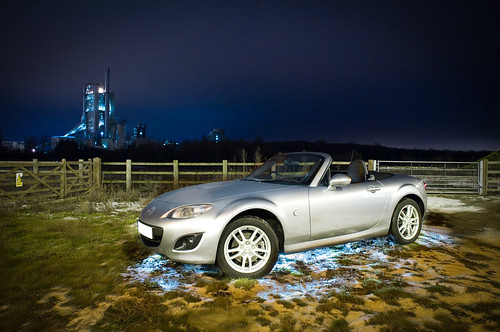
Headed out last night (eventually) with TP member and fellow Rugbian Lewis Craik after trying to fix something up for a few weeks where we could shoot one or both of our cars..
I've never shot cars other than quick snaps, so doing a staged car shoot was exciting, even if my mind had gone a bit blank as to what I was going to do.
Instead of trying to overcomplicate the composition with two cars, we opted to photograph Lewis' lovely MX5, a car that was also notably cleaner than my Volvo!
The idea was to use long exposures (20-30 seconds with the camera set at f/8 and ISO 100), with the help of an ND4 filter to allow us to pump plenty of flash into the the car and then piece individual shots together (over a background exposure of Rugby cement works) to combine area of evenly-lit paintwork.
Typically, I bit off more than I could chew by trying to merge 15 different exposures into one final image; some shots had too much light, others not enough, and invariably, I'd tried to get clever with different white balances, which only added to the difficulty of merging shots in Photoshop. Anyway, we live and learn and it's taught me A) not to run before I can walk, and B) a bit more thought beforehand can massively alter the amount of work to be done after the shoot.
Although I'm not really happy with the final result, it's a point from which I can work and learn from…
*Nikon D2x
*Nikon 17-55mm f/2.8
*ISO 100
*Nikon SB-700 fired manually (set to 1/4th power)
*Exposures were f/8 @ 20-30s with an ND4 filter
*Processed in Photoshop CS3 and Lightroom 3
Tuesday, 7 February 2012
Wren
I don't do bird photography as a rule, but being outdoors most of my work days I do get to see all sorts of wildlife.
The journalist I was with today (Kev Wilmot, editor of Total Coarse Fishing magazine) was, in another life, the editor of a bird watching magazine so we have all sorts of talks about bird life through the day, really fascinating stuff.
He was telling me that wrens are the commonest UK bird and that many succumb to winter temperatures but nature always restore the balance. At that moment, out popped this little chap to feed on some maggots we had on the bait table.
Thankfully I had the 70-200 on the camera but out of 15 or so shots, I had three keepers - I can't get over how quickly these birds move, much faster than 1/125th could reliably freeze. Thank God that fishing isn't so fast-paced....
*Nikon D2x
*Nikon 70-200mm f/2.8 VR
*ISO 400
*1/125th @ f/5.6
*Processed in Lightroom 3
Wednesday, 1 February 2012
Holiday Time

It's been a busy end to 2011/start to 2012 and what with video editing duties, time off for the festive period, and going on holiday to France, I've not had much time to post new material.
This shot is something I knocked up while on holiday in the French Alps. I'\d intended to do a load of shooting with my pro gear but the lure of time on the slopes with my snowboard was too much so I stuck to taking snaps on the other half's compact. It was actually refreshing doing this, as it gave me a chance just to shoot what I saw as a memory instead of aching over exposure and what-not. It was also surprising how good these little compacts can be at times - this is several images pieced together in Photoshop but the camera did a great job as I panned, giving no difference in exposure with each frame.
It was a great time away and I'm now wishing I could get away for a few days on a photo-specific trip. Maybe it'll happen but in the meantime, I'll just look at shots like this and remember the good times....
Wednesday, 4 January 2012
Double Exposure: Canon vs. Nikon
Saw this on Talk Photography the other day and just thought it a nice piece of work, taking the micky out of the Canon Vs Nikon debate that rages endlessly on photography forums.
I'm in the Nikon camp on this one ;)
